![]()
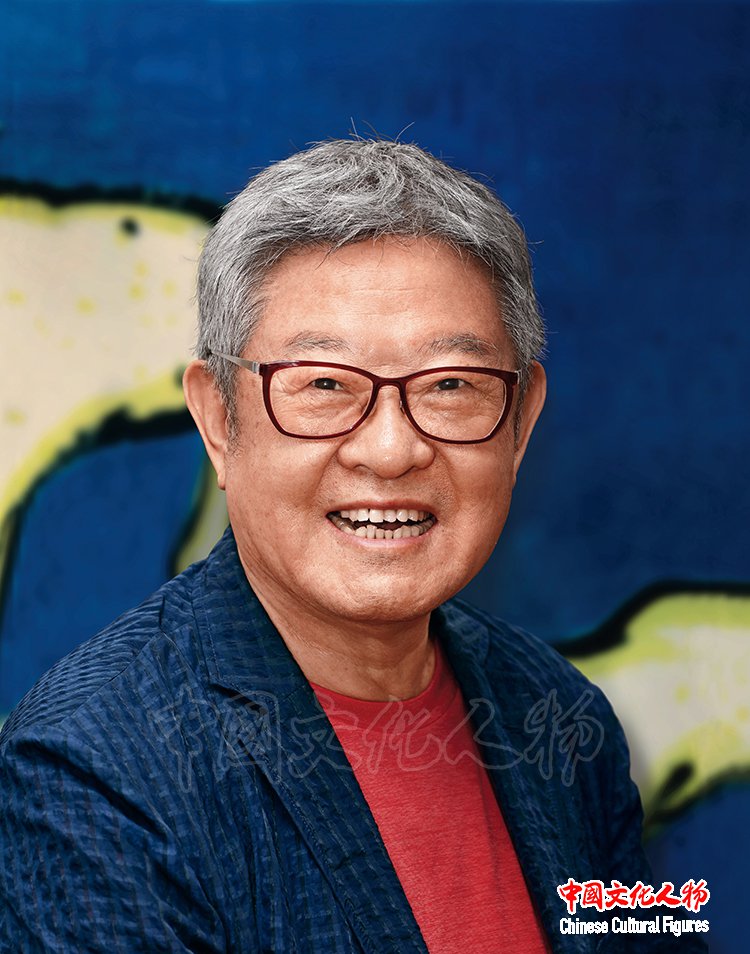 Jiang Baolin, a doctoral tutor of at the National Academy of Arts of China, member of the China National Academy of Painting, and vice president of the Li Keran Painting Institute, is an internationally acclaimed artist, deeply rooted in tradition, innovative, diligent in exploration, and remarkably productive.
[Chinese Culture People By Editor-in-chief Wang Baosheng/text and photo]
Jiang Baolin, a doctoral tutor of at the National Academy of Arts of China, member of the China National Academy of Painting, and vice president of the Li Keran Painting Institute, is an internationally acclaimed artist, deeply rooted in tradition, innovative, diligent in exploration, and remarkably productive.
[Chinese Culture People By Editor-in-chief Wang Baosheng/text and photo]
 A Section of Helan Mountain, 117×64cm, 1990, by Jiang Baolin, Government Award at the 26th Monte Carlo World Competition of Modern Paintings
A Section of Helan Mountain, 117×64cm, 1990, by Jiang Baolin, Government Award at the 26th Monte Carlo World Competition of Modern Paintings
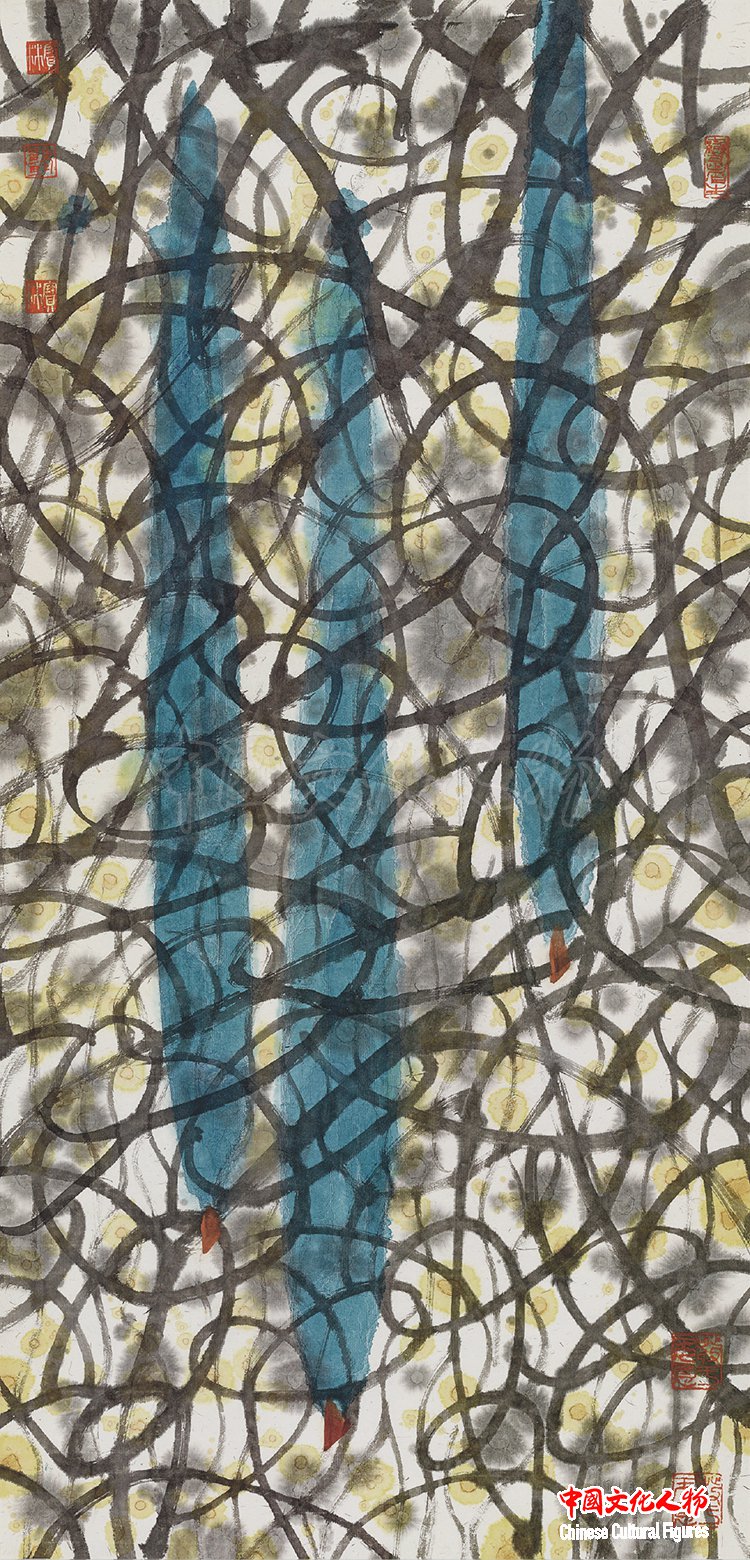 2018 • No.30, 69×138cm, 2018, by Jiang Baolin
2018 • No.30, 69×138cm, 2018, by Jiang Baolin
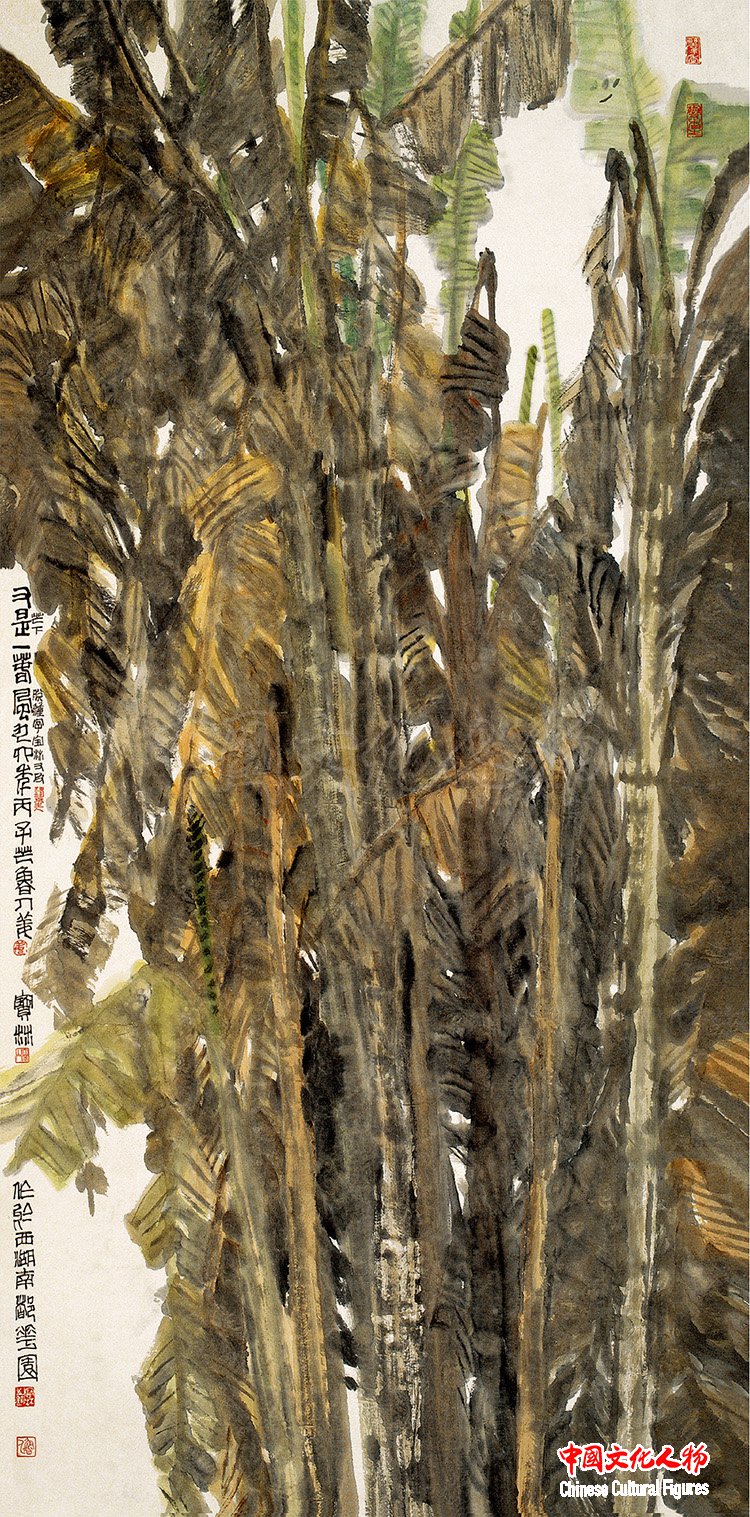 Spring Again, 250cm×123cm, 1996, by Jiang Baolin, Silver Award at the 9th National Art Exhibition
Spring Again, 250cm×123cm, 1996, by Jiang Baolin, Silver Award at the 9th National Art Exhibition
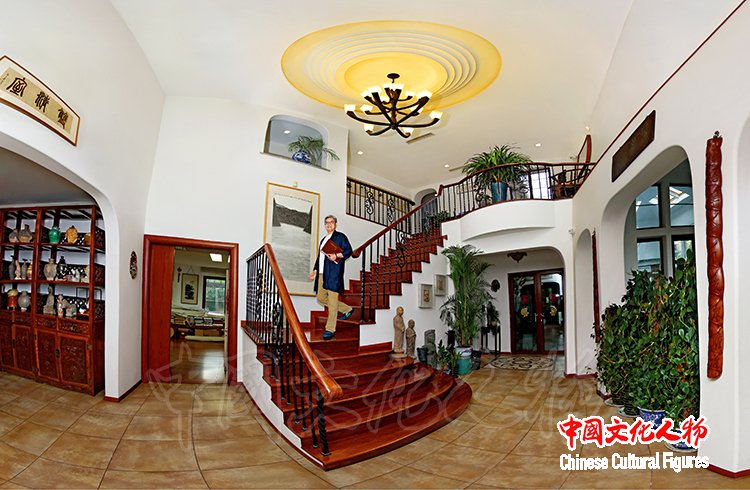 During his decades of artistic practices, Jiang Baolin, in face of the modernist reform of Chinese painting, has bravely shouldered the mission of the times and made explorations from line drawing of landscape painting to new abstract brushwork. He has not only initiated the abstract ink and wash art, but also created a large number of modern works with extensive influence and global significance.
During his decades of artistic practices, Jiang Baolin, in face of the modernist reform of Chinese painting, has bravely shouldered the mission of the times and made explorations from line drawing of landscape painting to new abstract brushwork. He has not only initiated the abstract ink and wash art, but also created a large number of modern works with extensive influence and global significance.
 Jiang Baolin's Global Art Exchange Atlas
Jiang Baolin's Global Art Exchange Atlas
 "Table Mountain" of 367 x 144cm, Jiang Baolin's works in 2011
"Table Mountain" of 367 x 144cm, Jiang Baolin's works in 2011
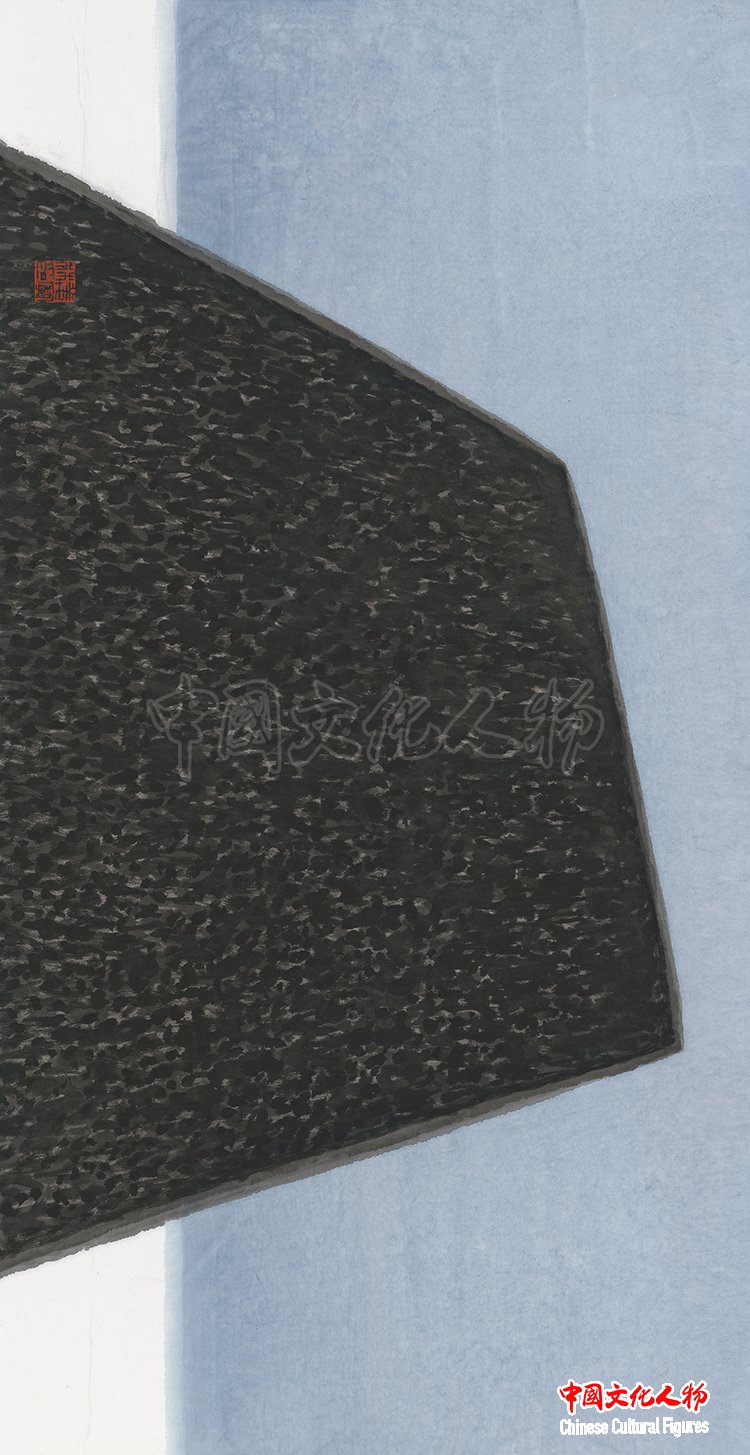 " No.2016.1 of Black, White and Grey Series" of 70 x 138cm, Jiang Baolin's works in 2016
" No.2016.1 of Black, White and Grey Series" of 70 x 138cm, Jiang Baolin's works in 2016
 " 2018•No. 4" of 69 x 138cm, Jiang Baolin's works in 2018
" 2018•No. 4" of 69 x 138cm, Jiang Baolin's works in 2018
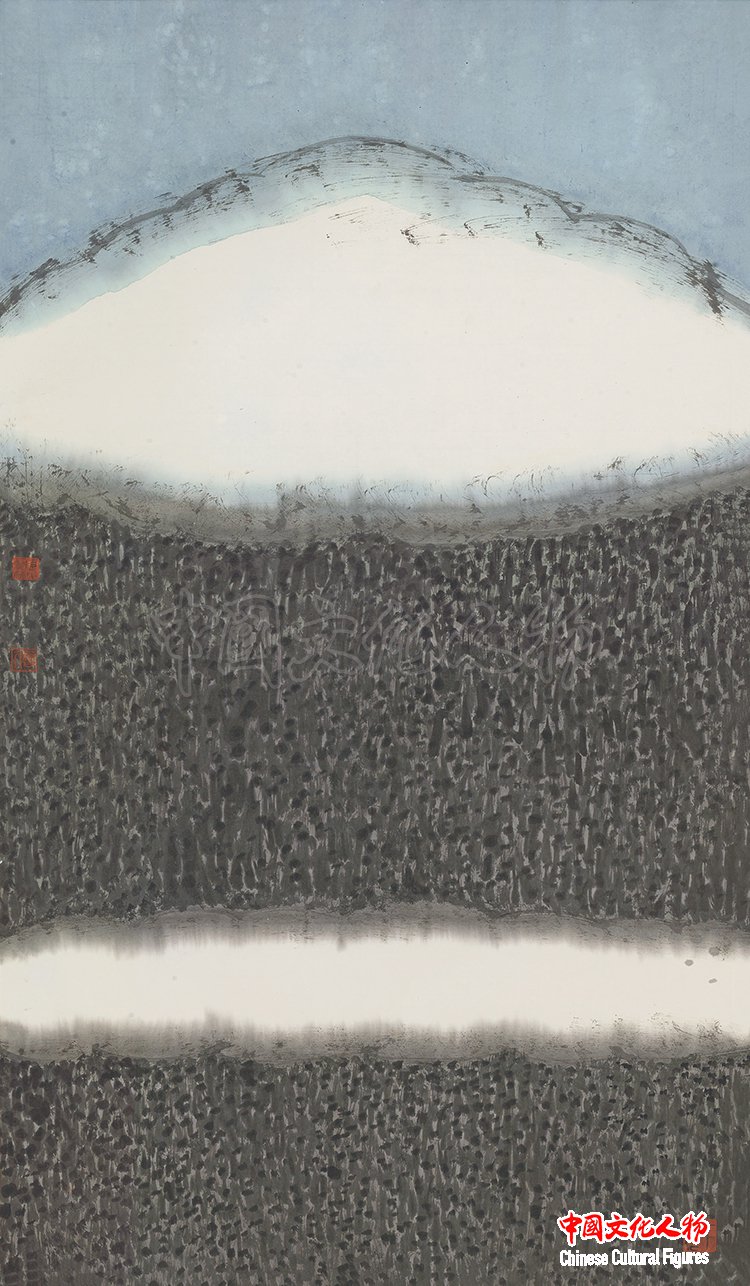 "2017•No. 22" of 69x138cm, Jiang Baolin's works in 2017
"2017•No. 22" of 69x138cm, Jiang Baolin's works in 2017
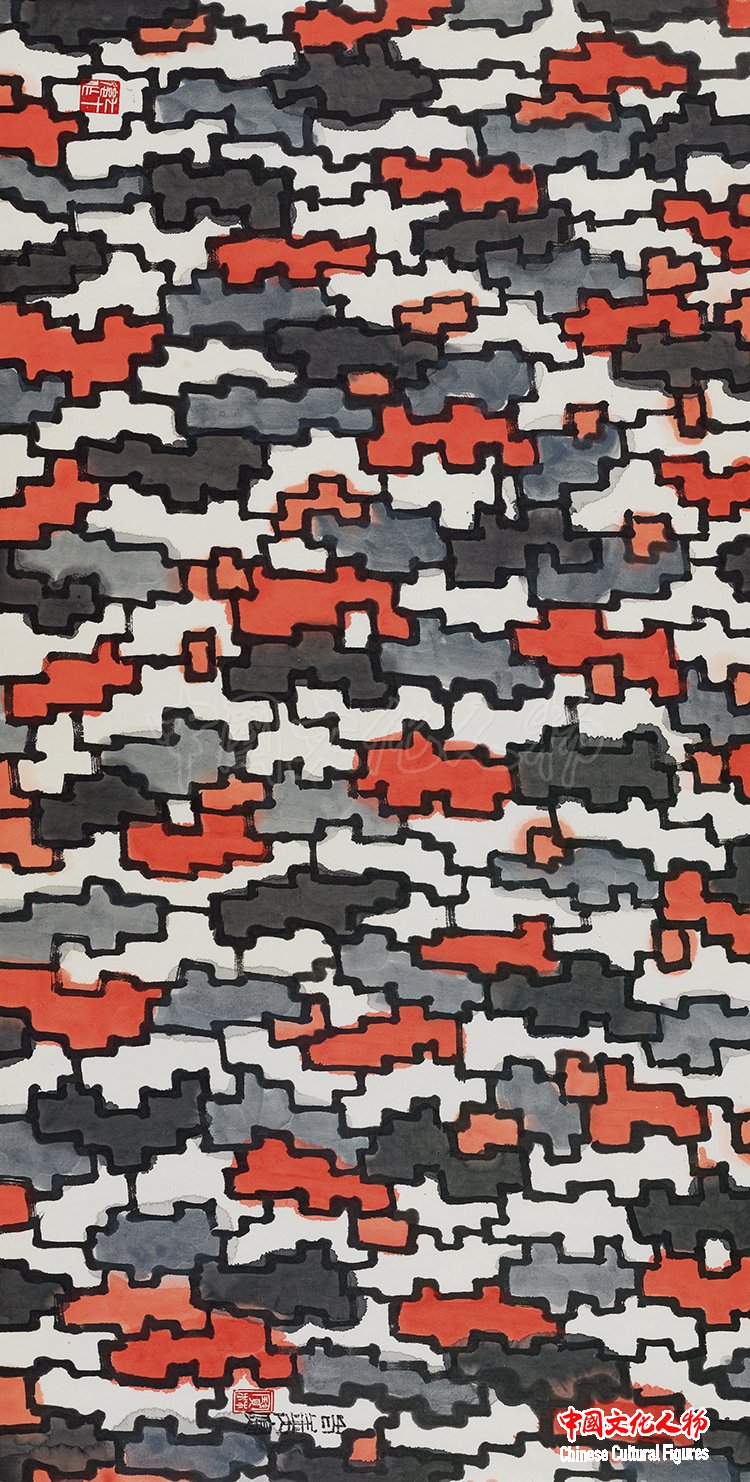 "2018• No. 31" of 69x138cm, Jiang Baolin's works in 2018
"2018• No. 31" of 69x138cm, Jiang Baolin's works in 2018
 "No. Five of Soft Breeze and Screen Mountain Series" of 144x365cm, Jiang Baolin's works in 2018
"No. Five of Soft Breeze and Screen Mountain Series" of 144x365cm, Jiang Baolin's works in 2018
Chinese Culture People (By Editor-in-chief Wang Baosheng)Mankind has created multicolored forms of civilizations in the long history. Scrutinizing the Chinese civilization through the long lens of history, we can see a colorful picture of greater exchange and stronger mutual learning among civilizations featuring prosperity and splendor. The inter-civilizational exchanges and mutual learning have been vividly embodied by the following practices: the establishment of the Silk Road (a network of trade routes connecting China and the Far East with the Middle East and Europe) since China’s Western Han Dynasty; Jianzheng, or Ganjin in Japanese, visiting Japan to propagate Buddhism in Japan, and Xuanzang’s journey to the West, a Buddhist monk and Chinese pilgrim to India who translated the sacred scriptures of Buddhism from Sanskrit into Chinese in China’s Tang Dynasty; Zheng He’s seven expeditions to the Western Ocean in China’s early Ming Dynasty; the Introduction of Western learning and the New Culture Movement since the modern era; the introduction of Buddhism and the confluence of Islam and Confucianism in the old days; and the unique enjoyable painting of China in combining the Chinese painting in the traditional style with Western oil painting. What we have learnt from these practices above is that we must strengthen cultural confidence and expand civilization exchanges to allow traditional culture to bloom in the era of greater exchange and stronger mutual learning, in an effort to make the Chinese civilization keep developing and prosperous. This will function to provide spiritual strength for the construction of a community with a shared future for mankind, and jointly compose a new chapter of the development of human civilization.
Jiang Baolin, a doctoral tutor of at the National Academy of Arts of China, member of the China National Academy of Painting, and vice president of the Li Keran Painting Institute, has combined traditional Chinese painting style with western oil painting in practice, focusing on both tradition and modern elements. While persisting in inheriting the roots of Chinese folk art, he advocates promoting the creative transformation and innovative development of our fine traditional culture, and has created the new abstract ink-painting art based on tradition. As a result, he has formed an artistic concept that “it is necessary to be both traditional with extreme conservation and modern with bold and arrogant creation in ink painting”, and created a large number of modern works with wide influence and world significance. Since China's reform and opening up, he has proactively participated in the exchanges and dialogues among different civilizations, promoted Chinese civilization in greater exchange and stronger mutual learning, and built a bridge of communication between different countries and nations by means of art.
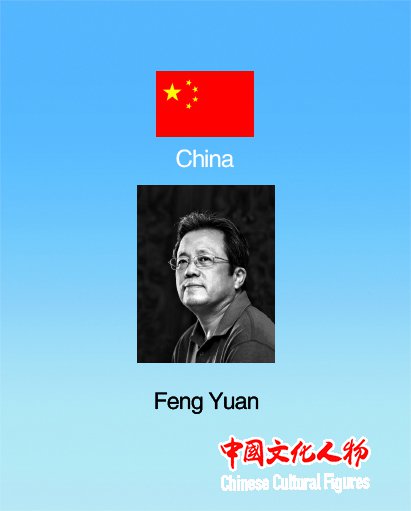
Feng Yuan: Physical Situation, Situation, Artistic Conception, Objective Things, Mental Images, Images
——The Artistic Appreciation of Jiang Baolin's Chinese Paintings (Excerpt)
Text / Feng Yuan
In the artistic works of the painter, Jiang Baolin, there is a strong Chinese artistic style, which is not classical and traditional. He intelligently chose and discarded, strengthened and absorbed in the practice of integration between Chinese and Western culture, but there are few weird problems. His creative concept is undoubtedly modern and creative without deviating from the roots of Chinese national art. The painter himself is "a wizard without losing true self, painting with magnificent skills without discarding essence." Among contemporary painters, he is a painter with outstanding performance and significant achievements. The reason why Jiang Baolin’s art has gained good marks from experts and peers, I think it may be due to the extraordinary artistic sentiment and artistic attainments conveyed by controlling the three realms and the three levels: physical situation·objective things —— situation·mental images——artistic conception·images through many years of his mortification.
——Without taking physical situation, I seek for the true objective things.
The expression of "an object" and "physical situation" in Chinese paintings of the past dynasties is the first realm and the primary standard for the pursuit of works. Jiang Baolin, who graduated from the Chinese Painting Department of the Zhejiang Academy of Fine Arts in his early years, is familiar with the history of painting. Certainly, he knows its importance. He studied landscape paintings from Lu Yushao and Gu Kunbo. He not only attached importance to the creation of painting from life, but also attached great importance to the creation of writings and paintings, continuously improving the capability of expressing the modelling structure of the natural landscape and increasingly understanding the richness of language. Life experience makes Jiang Baolin experience the mutually indebrushdent relationship between man and nature, man and landscape in the countryside, which lays a very good foundation for an artist's growth influence, accumulation and pursuit of “physical situation”——"Objective Things" in art creation.
After Jiang Baolin was admitted to the Central Academy of Fine Arts, he changed to learn from Li Keran in the North China instead of learning from Lu Yanshao in the South China, and he changed to essentially study many instead of one or two. Changing to learn from many masters and widely absorbing has broadened his horizons and expanded his knowledge with exploring his potential. "Express his feelings with his understanding and express his understanding with his feelings". Jiang Baolin really felt that the works of his contemporaries, teachers and schoolmates, being able to boom was achieved by the infiltration of art essence.
——Without conforming to situation, people's mental images are inspired later.
Jiang Baolin is not only an expert in the "image" and "heart", but also a master of "making love" and "making the world". Jiang Baolin's creation
However, the selected objects are extremely ordinary and simple, but these ordinary and simple objects are refined and brewed as “heart images”, which is an emotional, abstract and symbolized artistic image.
In the 1970s, Jiang Baolin's landscape paintings were written in a realistic way but without ignoring the methods of Chinese writings and paintings. They paid great attention to the imagery from the natural mountains and rivers of Fenghua and other places in Jiangsu and Zhejiang provinces. They used the traditional Chinese writings and paintings learned in the Zhejiang Academy of Fine Arts to express the real scene of Jiangnan. Fresh artistic rhythm, vivid Chinese writings and paintings, the connection between the language of painting and the object and the scene, and the heart fits very well. After learning from Li Keran, he changed from depicting the realm of Jiangnan to chanting the scenery of the Northland. The scenery was changed from being graceful and moisturized to being strong and broad. The painting style was changed from soothing to square, which was not only changeable, but also absorbed the ink splash and ink stain techniques of the teachers and friends. The prints that summarize the overall picture form processing and the colorful color features of the murals greatly enrich the creation of his "mental images" and the combination ability to convert the Chinese writing and painting language into a visual language.
The fullness of the "situation" presented in Jiang Baolin's landscape paintings is derived from the richness of his artistic "mental images", whether it is the charming and brightness of Jiangnan Water Village, or the bleakness of the northern vast Sichuan, all of which reveals his feelings overflowing in his works.
——Without attaining the artistic conception, it is difficult to create innovative images.
From "objective things" and "mental images" and "artistic meaning" to "conception", Jiang Baolin's success lies in his insight into the painting theories and skills.
In the 1980s, Jiang Baolin returned to Hangzhou for art. After experiencing the discussion of Chinese painting, he resolutely abandoned the original appearance that has been recognized by the society and began a new rush. From the extensive exploitation of the country, he turned to the fables of enlightenment of the western painting art. He once devoted himself to "making the conception" to break the time and space, go beyond the rules and Chinese writing and painting patterns of the ancient and modern masters, and absorb some elements of Western modern cubism school and abstract expressionism paintings, seeking for the breakthrough of the new conception, new meanings, and new images, and the style changes greatly. In the overseas exchange exhibition of works, he further reflected on the ancient and modern art of the West; reviewed the relationship between the evolution of art from the traditional to the modern, renewed the ancient times and embarked on a new way of returning to the tradition of art and language, and the return of art to the traditional spirit. In the early 1990s, Jiang Baolin reshaped and formed his new "image" language based on the mature art style. His line drawings of landscape are in a simple style to express the complicated objects, being further purer. The descriptive factors of expressing objects are greatly weakened, so the overall rhythm is strengthened and the symbolic features are more prominent. Compared to Western abstract paintings, the visual difference remained without the objective things abandoned.
The establishment and attainment of the three-situation and three-image innovative character of Jiang Baolin's landscape paintings are derived from his philosophical study, diligence and dedication. Certainly, he is inseparable from his indulgence and persistence in Chinese painting art.

Xue Yongnian: The "Chinese Writings and Paintings" and "the Modern" of Jiang Baolin's Art
Text / Xue Yongnian
Chinese Culture People (By Editor-in-chief Wang Baosheng)When Jiang Baolin was in his 70th birthday, he held a solo exhibition at the National Art Museum of China and held a seminar. The seminar was hosted by me. Mr. Liu Yulin and Mr. Zhao Lizhong are all there. The discussion was very enthusiastic. I said at the end: Baolin’s art has not been terminated. At the age of 75 and 80, the exhibition will be updated. He will 75 years old next year. This exhibition is more extraordinary. In general, the abstract factors have been increased. Some friends regard him as a representative figure in the writing and painting language's change of modern Chinese paintings, which is valid.
Writings and paintings are the core of Chinese painting art language. Jiang Baolin also attaches great importance to Chinese writings and paintings, but he also emphasizes that he also attaches importance to the modern of Chinese paintings. He said "Needing Chinese writings and paintings while needing the modern." He does not mean "Needing Chinese writings and paintings while needing artistic conception." It is not to say "Needing the traditional while needing the modern." Therefore, how the characteristics of Chinese writings and paintings in Jiang Baolin's art and the relationship between "Chinese writings and paintings" and "the modern" are understand? Both are worth thinking about. In the meeting notice, Jiang Baolin's Chinese writings and paintings are summarized with "the abstract constructivism of Chinese writings and paintings". This is of course a kind of opinion. However, in addition to the abstract and constituent factors of Jiang Baolin's Chinese writings and paintings, are there any other factors, such as any figurative factors?
Shi Tao of the Qing Dynasty said that "writings and paintings shall follow the times" and Chen Chuanxi of Renmin University said that "writings and paintings should follow the ancient times." The former means that writings and paintings should develop at any time and cannot rest on its laurels. The latter means that writings and paintings are the accumulation of history. To maintain the traditional genes, we must keep things that are constant in the writings and paintings. Then, Jiang Baolin's writings and paintings are so-called modern writings and paintings that only follow the time, or high-quality writings and paintings that express modern sense and historical accumulation. It needs to be combined with his artistic practice and his work to understand.
For the language of Jiang Baolin's writings and paintings, the main body is the language of Chinese paintings, and foreign words are also absorbed.
His writings and paintings are inseparable from the object of depiction, or basically do not leave the object to give him the feeling, but also cannot be separated from his artistic origin. The object he depicts is the impression of mountains, water, birds and flowers, or landscapes. His artistic origins can be traced from Lu Yushao, Gu Kunbo, Pan Tianshou, and Li Keran, to Huang Binhong, Qi Baishi and even Wu Changshuo, as well as ancient literati paintings, folk murals, paper-cuttings, and modern woodcuts. He also absorbed the Western modern art.
Undoubtedly, Jiang Baolin's writings and paintings are an important factor in his individualized artistic style. However, as a communication means and a communication bridge, artistic language is not unique to an artist. Language is not only historically inherited, but also has the universality of the contemporary in the same culture. Any painter needs to master the artistic language of the paintings he is engaged in, and then form his own personalized language in the process of “creating works from the nature and gaining ideas from inner feelings” and using the original artistic language, which is called " learning style of one school". For the formation of its unique artistic language, there is a process of exploration from inheritance to change. As far as I know, in the 1970s, Jiang Baolin mastered the traditional painting language and began to explore the individualized language.
Let's start with landscape painting. From about the late 1980s, Jiang Baolin's landscape paintings are based on the mature style of the past and actively explore and innovate. A variety of experiments have been done and some of the writing and painting factors have been usually separated from the previous landscape paintings, which are strengthened in extreme ways or the complicated of which is expressed in the simple style, or which extremely changes in purification with two different writing and painting styles of a strong personality formed and two unique styles of different faces introduced. One is the landscape line drawing that is simplified to almost any combination of lines and rhythm.
Jiang Baolin's landscape line drawing originated from the strong impression in going to the mountains and rivers in the western China. The characteristics are simple and simple. They almost completely weaken the rendering and rubbing, completely discarding the ink splashing, ink breaking and ink accumulation, and there are not many colors. It's almost just a combination of lines, or occasionally a lot of points. This kind of painting may originate from Lu Yanshao's cloud water images, but Jiang Baolin combines the strength of printmaking, the love of paper-cutting decoration, the sea cliffs of folk decorative patterns, the simplicity of ancient seals, and the beauty of composition in Western methods. From the perspective of brushes and ink, the brushes played the main role, simple and strong.
The other is the landscape paintings of accumulated ink. The points and lines are stacked for its great spectacle, which does not win with a brush, but with ink. The face is also very strong. This kind of work reinforces his feelings from Jiangnan, Northwest, Yandang Mountain and Lushan. His artistic conception is high and his brush and ink are thick and sullen. This kind of painting may be inspired by Li Keran's ink-collecting method, which emphasizes the spatial relationship between expressions. It is traced back to the style of point-line symphony in Dong Yuan's "Image of Xiao-xiang River" and "The Painting of Summer Scenic Mountain Pass to be Crossed", which is turned into Huang Binhong's "Wide squats of the sky and the earth with short lines and large points, overlapping layers, and accumulating". Like Li Keran's backlit light, he painted the light between the jungles and broadened the visual experience of landscape painting.
Jiang Baolin's freehand flowers and birds, painted objects, except for the Shannon series and the Shenmu series, are mostly ordinary flowers and trees painted by the predecessors, but they are very well painted. If you talk about the origins, it can be said that since the beginning of Pan Tianshou, thanks to Zhang Lichen's discussion, the beginning is magnificent, splashing, radiant, extraordinary. In the early 1980s, he mainly painted landscapes. From about the late 1980s to the 1990s, his freehand paintings and flowers were much more diverse, and he also brewed two kinds of his own faces.
A kind of face, thick and big leaves, simple refinement, stressing composition, rich sense of form. The other is a full composition. It seems to be inspired by the partial paintings of landscape paintings, which are painted into bushes of trees and flowers, or densely clumped branches, or heavy, or flashing sunlight, or floating fog, with bringing the medium scene to the present with close-up means, and introducing the tree method and the leaf method of landscape painting that are unconventional and not the same as others.
In recent years, Jiang Baolin also has a more abstract work, which is not easy to distinguish the objects he paints. He may be the first to be inspired by the landscape, or may be the first to be inspired by the flowers, and may also be inspired by some kind of paintings from the ancients. But it not only expresses inner feelings, but also has a strong sense of form. Throughout the landscape paintings and flower and bird paintings of Jiang Baolin's own school, it can be seen that there are three attributes of his writings and paintings in his paintings, one is figurative, the other is calligraphy abstraction, and the third is plane composition.
The so-called figurative representation refers to the function of the brushes and ink. Lu Ji said that "the prophecy is no more than words, and the form is no better than painting." The existence of shape does not mean competing with the camera, it does not need to be realistic, it is often "the wonderful existing between the similar and the non-similar". It debrushds on the indications and intentions of finite form, and enters the deep image. It does not exclude all the similar factors, and it is different from the abstraction of calligraphy, and the piece of "not similar" in "the wonderful existing between the similar and the non-csimilar" is reserved for the expression of the soul, leaving the calligraphy gesture and composition consciousness to be creative.
The so-called calligraphic abstraction refers to the writing function of painting strokes like calligraphy and trajectory. Of course, there is always a clear distinction between calligraphy and painting. Calligraphy is purely abstract, but it is inseparable from the framework of Chinese characters. Chinese paintings have not reached the level of the purely abstract in the past, but there is no shackle of Chinese characters. As an art, calligraphy has the function of lyricism. In the Tang Dynasty, Sun Guoting summarized it as “achieving his temperament” and “shaped his sorrow and joy”, that is, the relatively stable aesthetic feelings of expressing emotion and performance. The realization of this writing function relies on the trajectory of the brushcraft movement, and the quality of the stroke movement is guaranteed. There are two preconditions: one is the mastery of the basic point painting style, and the other is that the point painting makes the corresponding vertical and horizontal emotions correspond to the emotional personality.
The rhythm of the point painting corresponds to the individual life and spiritual character of the artist, but the movement of the point painting also reflects two connotations. The first is the "heart of the heavens and the earth" of "one yin and two yang that are called as Taoism", that is, the cosmic consciousness of the dry rotation reflects the yin and yang of nature, the ups and downs, the clutches, and the one is a world. Secondly, the life consciousness that expresses the "gluten and bones" is a life. This is the line of Chinese calligraphy that is essentially different from the lines of Western modern painters Mark Toby, Mather Will, Klein, and Pollock, who are said to be drawn in Chinese calligraphy.
In the traditional Chinese painting concept, a good work must not only have the specific content of the work, but also the cosmic consciousness, life consciousness and individual spirit throughout the brush and ink painting. It is necessary not only to have the imagery beauty of "the wonderful existing between the similar and the non-similar", but also to combine the painting form with the point painting movement as the rich and unified abstract beauty of nature and human heart. The abstract beauty is heaven and earth. One is the unity of Tao and technology, transcending my things, the past and the present.
Although the brushes and ink of Chinese paintings are different in point and line, they are different from the point of line in western painting. In order to realize the unity of life consciousness, cosmic consciousness and individual spirit, certain quality must be guaranteed. In this regard, Huang Binhong summed up the historical experience and summarized the "five strokes" and "seven inks": "flat, stay, round, heavy, change, thick, light, broken, splash, accumulation, coke, stain". The brush was used to reflect the Chinese philosophical thoughts: no longer undone, nothing to shrink, going to the right side at first when wanting go to left, going down when wanting to go up, accumulating points into a line, showing up and down, review left and right and knowing white to keep black. As for the use of ink, ancient people have long been discussed the first four he said and have practiced the latter three, and Huang Binhong summed it up, so he used the ink to a new height.
The so-called plane composition is the design consciousness introduced by many contemporary painters in Chinese painting. The introduction of design simplifies the pattern of corresponding objects, exaggerates the sense of form of composition, strengthens the impact of geometric graphics on vision, and highlights the artist's good personality. Some people say that cross-cultural art modernity has two signs, one is simplified form and the other is enhanced personality. The constituent factors are just that. However, Baolin's introduction of the plane composition has few normative geometric figures, but Huang Binhong's "uneven triangles" are more life-like.
As mentioned above, the characteristics of Jiang Baolin's art of writings and paintings, although the abstract factors in recent years are growing, but in general, it is still organic integration of figurative, abstraction of calligraphy and plane composition. These three attributes are closely combined, complement each other, rely on each other, and develop each other to realize the function of writings and paintings, realizing the pursuit of "Needing Chinese writings and paintings while needing the modern." He did not completely abandon the figurative representation because of the abstract nature of calligraphy, nor did he neglect the abstraction of calligraphy because of the plane composition. It was realized in the rhythm. It can be said that Jiang Baolin's writings and paintings, to a large extent, a unity that guarantees the compatibility of quality and obrushness, is the unity of adhering to the new machine of historical accumulation and absorption, and is the unity of the inheritance of fine traditions and the expansion of soil as much as possible.
Mr. Jiang Baolin's "Needing Chinese writings and paintings while needing the modern" is easy to be understood as a traditional writing and painting. In fact, writing and painting themselves are a concept of development. Before the Tang Dynasty, the painter had consciously pursued the calligraphy-like "bone method" with the brush, but the ink use was still in the blind stage. It was only in the late Tang Dynasty that the "ink being divided into five colors" and the "water rhyme and ink exposing" method were raised, which led to the conscious of the Five-Dynasties painters "who have brush and ink", and the Jing Hao of the Five Dynasties pointed out that "water aureole and ink exposing makes Tang Dynasty rising." Before the Song Dynasty, the performance of writings and paintings was basically the narrations of objects. The Song people said that "the brush is divided by its shape and quality, the ink is different from its yin and yang", and the basic function of writings and paintings is mainly to reproduce the objects.
After the Yuan Dynasty, the painter's writings and paintings consciously wrote the heart, and guided the change of the writings and paintings of the heart to guide the change of the mound in the landscape painting, and more and more developed the performance function. The performance function was further strengthened by Dong Qichang at the end of the Ming Dynasty. He believed that brush and ink is a sign that painting is higher than reality: "The strangeness of the world is not as good as the landscape; the fineness of the brush and ink is not as good as painting. "Refined brush and wonderful ink" and "emotional brush and funny ink" became the artist's primary pursuit. However, the realization of the landscape painter's brush and ink is also based on the stylized hawthorn stone, which is different from the abstraction of calligraphy. Since the late Qing Dynasty, that is, Huang Binhong’s “Rising in the Dao and Xian Periods”, the latest development of brush and ink is the prevalence of gold and stone pattern. This point not only covers the masters of Baolin, but also integrates the art of Jiang Baolin.
The performance of writings and paintings in the gold and stone pattern is characterized by two major characteristics, one is the beauty of force, and the other is the development of ink law. The former is mostly expressed in flowers and birds, while the latter is mostly in landscape painting. For this question, Dr. Li Ming, who I directed in the past, pointed out that "The Rising of Dao and Xian Painting School" is reflected in the field of landscape painting, which is the change of the brushcraft connotation caused by the absorption of the inscriptions and the rubbing effect in landscape painting, and the development of the tradition of using ink. In fact, the influence of the inscription on the Chinese brush ink has begun from the late Qing Dynasty, such as Zhao Zhiqian and Wu Changshuo, and many of the freelance painters throughout the 20th century. This is a clear example of the change of writings and paintings from generation to generation.
Jiang Baolin's "Needing Chinese writings and paintings while needing the modern" means that both the writing and painting skills and the modern sense are required, that is, the writing and painting skills are better, and the modern sense is stronger. For the understanding of his needing writing and painting, I think there are two meanings, one level means inheriting all the traditional techniques and valuable experience of the predecessors. The other level of meaning is to use the modern goal to drive the development of Chinese writings and paintings, that is, to adapt to the aesthetic changes of the times, to express the psychological feelings and visual experience of the community of destiny in the small global village in the information age. Full composition, decoration, planarization, extremely simplified, the golden stone texture of the writing skill, and the historical connection of symbols are all aspects of exploring the psychological and visual experience of modern people.
Therefore, in my opinion, Jiang Baolin's core content of “Needing Chinese Writings and Paintings While Needing the Modern” is: to play traditional genes, express modern aesthetics, update artistic concepts, and construct new forms. In the way of "not the same as others," look for new meanings, new situations, new forms, and new lines. To this end, its writing and painting language approach is to integrate Chinese and Western cultures with the main body of learning Chinese culture, and the artistic spirit is to return to the tradition and to be based on the modern. In fact, he uses the aesthetic concept of modern people to screen traditional graphic resources and writing and painting resources, segaregate them, optimize them, and strengthen them to achieve traditional modern transformation.

Jia Fangzhou: Jiang Baolin —— The Glass-breaker of Landscape Paintings
——On "Jiang's Landscape"
Text / Jia Fangzhou
Looking back at the process of Chinese painting since the 20th century, it is not difficult to see that the transformation and reform of tradition has become the basic theme of this era. Whoever puts his art on the basic point of reform and transformation, whoever consciously enters the context of this history, consciously shoulders the subject of the times and becomes an artist who is concerned by the times.
Since the 20th century, the changes in Chinese ink painting have basically taken place in two major systems. These two systems, one is the "inside-out" system based on traditional art; the other is the "outside-in" system of Western art as the stone of other mountains. In the system of “from the inside out”, several pioneering masters do not directly take the Western approach, but the clues they provide from different directions fully demonstrate the same in the highest form and fundamental law of Chinese and Western art. Sex. They pioneered the search for new mechanisms in the traditional self. Their explorations revealed clear modern intentions from different orientations: Qi Baishi led the literati's literati's taste to the folk taste, suggesting that folk art will become a modern ink painting. The great spiritual resources; Huang Binhong highlights the spatial order and charm of the brush and ink through the deconstruction of the mountains and stones, suggesting the modern abstract realm implied by the traditional "plum spirit"; Pan Tianshou is extremely visually strong with his "big articles" The sense of structure and casting feels a way of approaching the modern composition from the obrushing and closing of traditional painting. In the follow-up generation of painters such as Li Keran and Shi Lu, they also made different contributions. Waiting for Jiang Baolin's generation, he also tried to find a new mechanism in the tradition itself. In terms of achievement theory, he is undoubtedly an excellent successor to these pioneers.
Why is Jiang Baolin’s “New Landscape” a “Breakthrough”?
There are many comments about Jiang Baolin's art, and most of them talk about his "change". However, he only affirms his change in the general sense. For his planarized landscapes that were "changed" - he named himself "Landscape Line Drawing", I named it "Jiang's Landscape" - but did not give enough recognition, so this article will focus on discussing the meaning of this part of the works.
I always have an illusion: there are two Jiang Baolin appearing in front of me, one is a traditional painting of flowers and birds by a great author, and the other is a pioneer who breaks through the traditional landscape and creates another way.
As far as the former is concerned, Jiang Baolin can say that he has done a very good job, and he is very impeccable. But the most valuable part of his art I thought was not here. Because we can list a lot of tasteful, standard, and profound traditional painters, they are undoubtedly placed on the "pulse line" of the traditional veins, but this "pulse" is not because of their Art is extended, so although they are good painters, they are not meaningful painters. Jiang Baolin is often said to be “good” at this level, not his contribution to extending the traditional veins. But in my opinion, his artistic history does not mean that he is excellent as a big freehand flower and bird painter. It is not that he paints flowers and birds better, but that many people do not think that there is much "good" part. It lies in the part of people who have some doubts about his exploration. To put it bluntly, Jiang Baolin did not add a new thing to the basic construction of traditional landscape painting, but a “destructive” change to the traditional landscape painting pattern, the so-called “breaking”. In this regard, no one has clearly pointed out so far, that is, he himself, I am afraid that he will not admit that his actions are "rebellious" and will not admit his flattening and homogenization of landscapes. It will constitute a subversion of the traditional landscape painting pattern. But in fact, it is his actions that cut off the space of the traditional landscape that has always pursued the "Italian", and smoothed the landscape of the landscape full of space. The landscape of Chinese landscape painting lasted for thousands of years, until his mentor, Mr. Li Keran, gave up what he wanted. But he is not out of thin air. His flattening of landscapes is a modern perspective and comes from the visual experience of modern people. For example, we look at the mountains and mountains on the plane, which is flat and patterned. No matter how high the mountain is, what you see is only the veins and mechanism of the mountain. The river is a bright and curved line. The highway is a straight line. This kind of visual experience is not available to the ancients. Experience the top of the mountain and see the mountains." Jiang Baolin intentionally or unintentionally reflected this visual experience of modern people into his works, thus forming a new pattern of flattening. Therefore, his "planarization" treatment of landscape painting is not a "small change", not a minor repair in the form, but a big "change", a conceptual change that is not even certain by himself. Although this change is not very thorough in his practice, he must have seized and raised the issue of the modern transformation of landscape painting, and is advancing in this direction.
Here we may wish to make a brief analysis of his "Jiang's Landscape"
"Jiang's Landscape" can be roughly divided into four types: First, the texture and structure of the rock are expressed in pure lines, such as "Helan Mountain's One Section" (in 1990), "Revelation of Dunhuang", "Friends" (in 1996), "The Order in the Beginning" (in 1996), "Western Mountain Stone" (in 1997) "Vermont" No. 1 (in 1999), "Mountain Landscape in the Western Land" (in 2011) and so on. This kind of work still retains some space and dense space imagery, but there is no painting outside the mountain stone; secondly, the overlooking landscape with some decorative fun, such as "Quiet" (in 1994), No.1 and No.2 "Record of Travel in the Western Land" (in 1994), "Mirror", "Autumn Mountain" (in 1995) " Coming from the Heaven" (in 1996), "Silence" (in 2001) and so on. This kind of overlooking landscape has only the "uniform" mountain texture and the blank as "water"; thirdly, the broad wide-screen composition, flattened rocks or groves evenly spread the picture, and the bottom of the bottom has a spatial sign. Upper arc, tree or architectural outline, such as "Mother's Hands", "Spring", "Summer", "Autumn", "Winter", "Reminiscence of the Desert" (in 1998), No. 8 of "Vermont" and etc. This kind of central point of the giant system is a personalized schema structure that Jiang Baolin loves; Fourthly, the purely flat composition, there is no hint of any space, and the center and the edge, such as: "Narrow Road" , "Rain Break" (in 1998), No. 2 and No. 3 of "Vermont", "Rhythm" (in 1999) and so on. This kind of work marks that "Jiang's Landscape" has evolved into a purely abstract state, and it is a traditional and real writings and paintings.
Formally, "Jiang's Landscape" contains such elements: First, the performance of the method is simplistic, the smear is omitted, only the line is used; Second, the performance object is unified, all the natural visual factors All will be deleted, leaving only mountains and water, or a single grove; third, using "repetition" means to order the mountain structure; fourth, the "structural units" that are close to abstraction are evenly spread over the picture, and all possible directions The visual factors of spatial depth are reduced as much as possible, or symbolically and symbolically limited. The result of the addition of these means is the emergence of a flat or even decorative pattern structure, that is, the birth of a "Ginger landscape" full of modern factors. It is this flat landscape that makes Jiang Baolin's art surpass the predecessors and peers, so that he has created a new pattern without delaying the old brush and ink, extending the veins of the landscape and the landscape painting. The context below continues with "below".
What needs to be explained here is that these basic elements that make up the transformation of “Jing's Landscape” into modern times are not directly taken from the modern concept of the West, but gradually upgraded from his own exploration, from traditional art, folk art and himself. The reality feels that it is deeply rooted in the traditional culture. This is a kind of “modernity” developed from its own tradition. Although it does not rule out the factors that absorb some Western modern art, its coordinates are based on the foundation of powerful traditional art.
The Modern Road from Huang Binhong to Jiang Baolin
Jiang Baolin’s road from traditional art is very close to Huang Binhong. Huang Binhong is a smooth and natural coincidence in the self-discipline of traditional literati painting, and close to some Western modern art concepts. For example, Huang Binhong’s idea of crossing the objective external image and reaching his “inner beauty” is indeed the same as the flourishing of Western abstract art. Kandinsky has a very sincere belief in the inner spirit of the material world. He firmly believes that truth can no longer be found on the visible surface of objects. Truth exists only in the inner world of objects. The desire for expression of this invisible inner world and inner spirit prompted him to abandon the depiction of the visible world and embark on a purely abstract path. Mondrian also sees the external world as an obstacle to reaching the spiritual realm. In order to eliminate this obstacle, he also seeks purely abstract expressions away from the external form, thinking that this is the essence of the world. Although Huang Binhong does not absolutely oppose the external world and the abstract spirit, he "paints the mountains, which does not have to be like mountains", "draws water which does not have to be like water", then, what is "must"? "Inner beauty is fully focused on"! The idea of “Inner beauty being fully focused on” rather than “every aspect of the face being focused on ” is also to abandon the “seeking truth on the visible surface of the object” and extend the artistic tentacles to the inner world of the object (that is, what he calls “inner beauty”). In this sense, Huang Binhong and Kandinsky and Mondrian belong to the same level of development. Therefore, Huang Binhong's art surprised us to discover that this seemingly traditional and conservative painter is truly a pioneer who transcends the times. When the whole era is still immersed in how to imitate the West to more realistically reproduce reality, he has used his art to leisurely extradite traditional literati painting into a new value system. Through his art, he foreshadows traditional literati painting and new choices were made in a new era environment. Huang Binhong not only established his own art hall in the sense of the ontology, but also promoted the traditional literati painting to a new stage, and exerted the Chinese writings and paintings into a rather pure state, and established a very simple character in the art. This kind of "pureness" is realized from the tradition. As he said, whenever you look at the ancient famous paintings, you must "hook the contours of the hills and sorrows. As for the coloring method, you don't pay much attention." Therefore, he often uses the "hook ancient painting method" to attain the rhythm and rhythm of natural life. And this is the pursuit of Baolin's landscape line drawing, isn't it? The difference is that Baolin not only extracts the outline, but also the structure and texture of the mountain stones. Apart from this, it is not as good as the rest. Therefore, he is more extreme, purer and simpler than Huang Binhong. If Huang Binhong’s “heavy, strong, gorgeous and moisturized” style is still a kind of “space illusion”, then Jiang Baolin’s those reciprocating parallel curves make the paintings completely formalized and “flattened”. The static beauty of the plane has made its viewers unwilling to return to the three-dimensional space.
The Concept of Planarization and Misunderstanding of Planarization
It is necessary to clarify the theoretical issues concerning "plane" here. Otherwise we can't explain why his "planarization" was questioned and cold welcomed in the group that praised him.
Art goes out of classicality and relies on misunderstanding of oriental art (such as Japan's ukiyo-e). Because the line shape of the oriental art tends to be flat in effect, this is also the view held by Baolin, but its "plane" is only the effect of the painting, due to the characteristics and limitations of materials and techniques rather than its concept and conscious pursuit, but the planarization of Western modern art is placed in the concept, what they are determined to pursue.
We generally understand modern art, that is, a visual revolution since the impressionists, and this revolution is aimed at classical art and college art. If this specificity is more specific, it is what Greenberg said. The "planarization process". It is to gradually simplify the three-dimensional space of the three-dimensional modeling of college art and classicism into a plane. This process was completed from Mana and finally to minimalism. Therefore, the plane effect of the oriental art paintings and the plane pursuit of Western modern art are completely different things.
Although traditional Chinese art does not have the stereoscopic and deep sense of Western classical painting, it creates a real space illusion. However, its space requirements and spatial imagination are persistent and strong. For example, traditional painting pursues the "artistic conception". The artistic conception is a kind of "space illusion" caused by the painting. The viewer realizes the expectation of the "space atmosphere" by watching the painting. Therefore, if the "writing" is the bottom line of Chinese painting in terms of the "machine" level, then at the level of "Taoism", the bottom line of Chinese painting should be "artistic". Therefore, landscape painting without artistic conception is unacceptable. Another example is the “three far-reachings” pursued by landscape paintings – plane far-reaching, high far-reaching, deep far-reaching, and not only “observable”, but also “approachable” and “habitable”. These concepts are all trying to find the real feelings of reality in landscape paintings, and look forward to the emergence of spatial illusions in the "viewing" of works. The "God" in the theory of "writing the gods and combining the gods and the gods" actually means that the image has the feeling of "living" and has a sense of life, which can cause the "motion" illusion. Therefore, how to break through the planarity of painting, how to depict the authenticity of space, how to make the object being depicted live and vivid, such as life (such as Zhang Sengyou painting dragon does not pay attention to the eye, that is, the allusion of "lightning breaking the wall, taking the clouds to go") can be said to be the three-dimensional goal that all two-dimensional classical art wants to pursue. The above allusions can be seen in the imaginary imagination of traditional paintings on space and on life.
The rebellion of modern art to classical art is reflected in such a "flat" concept. Friends of the Chinese painting industry did not give enough recognition to the "Jiang's landscape", it is because they are still dominated by the traditional concept of landscape, and the artistic conception of the landscape painting ("space illusion") is still their psychological expectation. The flattening trend of Baolin's works just weakens the creation of "Ideology" and blocks the viewer's fascinating imagination, thus guiding the viewer to another aesthetic category.
"New Landscape" Responding to Western Modern Art Theory
The modern factors contained in "Jiang's Landscape" can be strongly responded to by Greenberg's argument. Greenberg is considered as the most authoritative interpreter of Western modern art. There are several key words in his theory and let us compare them:
For the principle of unity, he said: "Reconfirming unity... is the most cherished thing in art talent." "A great work of art is... something that has the greatest diversity and maximum unity at the same time. ". “In almost all of the original paintings, it is the flatness of the reconstructed surface that creates the power of art.” He commented that Mondrian’s paintings were “transparent, harmonious and solemn-- The passion of control and cooling, the struggles that are solved, and the unity imposed on diversity.” In Baolin’s “New Landscape”, we seem to be able to taste this “controlled and cooled” Passion, see this "unity imposed on diversity." Therefore, the "unity" of the picture takes place under the condition of confrontation with "diversity", which is a difficult struggle to be solved by "unity". As Baolin said, "The more contradictions in manufacturing, the better the unity."
The Concepts of "Equivalence", "Decoration" and "All-over Painting"
In Greenberg's view, "equivalence" is the principle of modern "high art." “Equivalence” “monotonously echoes. This monotony makes the unity of the work self-evident, while at the same time making the work highly intensive enough to stimulate meaningful feelings.” And “the continuous accumulation of similar feeling units "causes the decoration of the works. "Decoration" is often used in the sense of commendatory and derogatory. The appearance of Matisse makes the decoration positive, and Mondrian's painting is also close to the decoration. He believes that "a painting that considers itself completely identical to its surface cannot be made to decorate." The concept of "all-over painting" is "the most complete modern painting, with the most abstract unity and the most direct understanding of the medium, is 'eliminating the center', ' [all-over] painting. This painting is composed of the same diversity or similar elements. It repeats itself from the end of the picture to the other end without much change, and susbrushds the fabric of the starting, middle and end surfaces". These arguments by Greenberg seem to be against the “Jiang's Landscape”. Is Baolin’s flat landscape not exactly this “equivalence” that makes “the work become highly densed” with “monotonously echoing”? Some of the huge works are not "dissolving the center", "polyphonic" and "all-over painting"! Isn't it the "fabric that repeats itself from the end of the picture to the other end without much change, and susbrushds the surface of the beginning, middle and end"? What is important is that these typical modern factors and modern artistic features in Baolin's works are not learned from the West, but from the roots of Chinese traditional art (including folk art). Take the painting "Autumn in the year of Gengwu" as an example. It is purely a traditional calligraphy writing, but the pattern created can be said to be an extreme tradition and an extremely modern one. Tradition can not only understand the spirit in Huang Binhong's writings and paintings, but also trace back to Wang Yuanqi's almost abstract mountain stone structure. To say that it is "extremely modern" is because the abstract pattern created by it more essentially reflects a landscape spirit. Therefore, Jiang Baolin's artistic significance is not only because he created a new landscape pattern, but also because it proves the "new change mechanism" of traditional art and proves its possibility of transforming itself into the modern one. From Huang Binhong to Jiang Baolin, this “from the inside out” road is a road of heavy mountains and waters, and it is also a road of dark and clear flowers. It is a road of hope that comes out in response to the changes of the times.(Chinese Culture People)
(Web edito :Zhao Jianhua)
 特别报道
特别报道














